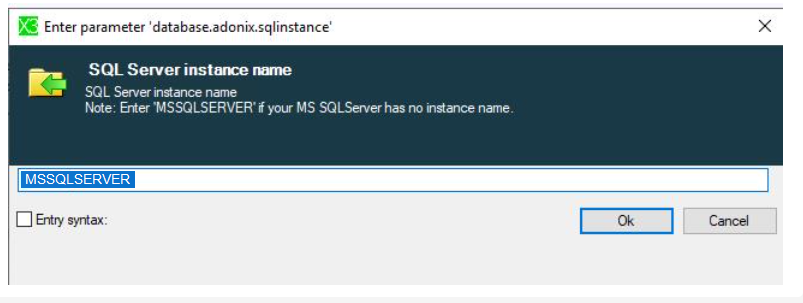Microsoft® Windows - Microsoft® SQL Server 2022/2019
This document describes the minimum configuration requirements when installing the Sage X3 software package application and data servers on a Microsoft® Windows - SQL Server 2022/2019 server.
| Category | Configuration requirements |
|---|---|
| Operating system |
Note: Since release 2025 R1/V12.0.37, Sage X3 does not support Windows Server 2016.
|
| Computer |
|
| RAM |
Minimum configuration for a server hosting Microsoft SQL Server and Sage X3 Application/Main Runtime (not Syracuse presentation tier)
|
| Disk space |
|
| Database software | Microsoft SQL Server 2022/2019 x64 Standard or Enterprise Edition, installed with the following options:
|
| Software prerequisites for Sage X3 components |
Note: From version 2022 R2 onwards, the use of Apache server is deprecated. It should only be installed in case your Sage X3 install requires one of the following applications:
|
| Mail server |
|
| Windows user accounts |
|
SQL Server Management Studio
SQL Server Management Studio is not a prerequisite for configuring a Sage X3 V12 Runtime component.
However, you might need this tool to install components for performing SQL Server database management on some of your servers hosting Sage X3.
Since SQL Server 2016, SQL Server Management Studio is not delivered anymore on the SQL Server Database installation medium. You must download it from the Microsoft website.
Microsoft released multiple versions of SQL Server Management Studio around the same time as SQL Server Database versions.
- With SQL Server 2017, you can use:
- SSMS 17.x
- SSMS 18.x
- With SQL Server 2019/2022, you should use SSMS 18.x in its latest version (18.9.1 as of May 2021).
Pay attention to the fact that:
- SSMS 16.x and 17.x include SQLCMD.exe and BCP.exe utilities in 32-bit variants only.
- SSMS 18.x does not include SQLCMD and BCP utilities. You might need to install these utilities from another Microsoft installation package. See below.
Useful links for SSMS
The following links are in English, but there are localized versions of these pages.
- Generic link for the latest version: https://docs.microsoft.com/en-us/sql/ssms/download-sql-server-management-studio-ssms
- Previous versions: https://docs.microsoft.com/en-us/sql/ssms/release-notes-ssms?view=sql-server-ver15#previous-ssms-releases
SQLCMD and BCP utilities
From Sage X3 V12, the SAFE X3 Management Console and the Sage X3 Supervisor use the SQLCMD.exe SQL Server utility to:
- Check and retrieve the SQL Server instance characteristics during configuration through the SAFE X3 Management Console.
- Create the SQL Server database for Sage X3 Solution in the SQL Server instance (when you create the database through the SAFE X3 Management Console).
- Create SQL Server users and schemas when importing a folder through the SAFE X3 Console.
- Create SQL Server users and schemas when creating a new folder in the Sage X3 Supervisor.
- Export sequence values when exporting folder data and import sequence values when importing folder data from SAFE X3 Management Console or Sage X3 Supervisor.
- Perform various database verifications or management procedures in the Sage X3 Supervisor.
SQLCMD is a prerequisite for configuring all runtime components involved in a Sage X3 Solution. Especially in a multi-main configuration which is a candidate to enabling the application cluster mode.
Besides that, the BCP.exe utility (which comes with SQLCMD) is only used by the SAFE X3 Management Console when performing the following operations:
- Folder copy in the same Sage X3 solution
- Remote folder import (from one Sage X3 solution to another)
- Folder export or import using the BCP data format option
There are different cases to consider regarding the SQLCMD prerequisites.
- The Sage X3 runtime is in the same host as SQL Server RDBMS:
In this case, SQL Server RDMBS embeds SQLCMD.exe. You have nothing to do.
At configuration time for the SQL Server database parameters, select the proper ODBC tools path as:- SQL 2017: C:\Program Files\Microsoft SQL Server\Client SDK\ODBC\130\Tools
- SQL 2019/2022: C:\Program Files\Microsoft SQL Server\Client SDK\ODBC\170\Tools
The Sage X3 runtime will use the path set up for the database configuration to find the proper SQLCMD.
- The Sage X3 runtime is in a different host as SQL Server RDBMS:
In this case, you should do as follows:- With SQL Server 2017:
You can use one of the following methods (you can also combine both):- Install SSMS 17.x in the Sage X3 runtime host and leverage embedded (32-bit) SQLCMD and BCP
- Install (64-bit) SQLCMD and BCP version 14 or higher from Microsoft SQL Command Tools redistributable
- With SQL Server 2019/2022:
- As SSMS 18.x does not embed SQLCMD and BCP, you must install (64-bit) SQLCMD and BCP version 15 from Microsoft SQL Command Tools redistributable
- With SQL Server 2017:
You need to download the Microsoft Command Line Utilities for SQL Server package to install the SQLCMD and BCP utilities.
Installing SQL Server Command Line Utilities requires installing the SQL Server ODBC package in the same version before.
SQL Server ODBC
Download links
- Up to SQL Server 2017:
- Microsoft Command Line Utilities 14 for SQL Server: https://www.microsoft.com/en-us/download/details.aspx?id=53591 (choose the 64-bit package)
- Microsoft ODBC Driver 13 for SQL Server: https://www.microsoft.com/fr-fr/download/details.aspx?id=50420 (choose the 64-bit package)
- Up to SQL Server 2019:
- Microsoft Command Line Utilities 15 for SQL Server:
- Microsoft ODBC Driver 17 for SQL Server:
- Up to SQL Server 2022:
- Microsoft Command Line Utilities 15 for SQL Server:
- Microsoft ODBC Driver 17 for SQL Server:
- Documentation: https://docs.microsoft.com/en-us/sql/connect/odbc/download-odbc-driver-for-sql-server
- 64-bit package: https://go.microsoft.com/fwlink/?linkid=2156851
Normally, the Sage X3 runtime component IZpack installer from version R93.2 delivered with Sage X3 12.0.25/2021 R1 embeds Microsoft ODBC Driver 17 for SQL Server. After installing the Sage X3 component, you might need to install Microsoft Command Line Utilities 15 for SQL Server.

